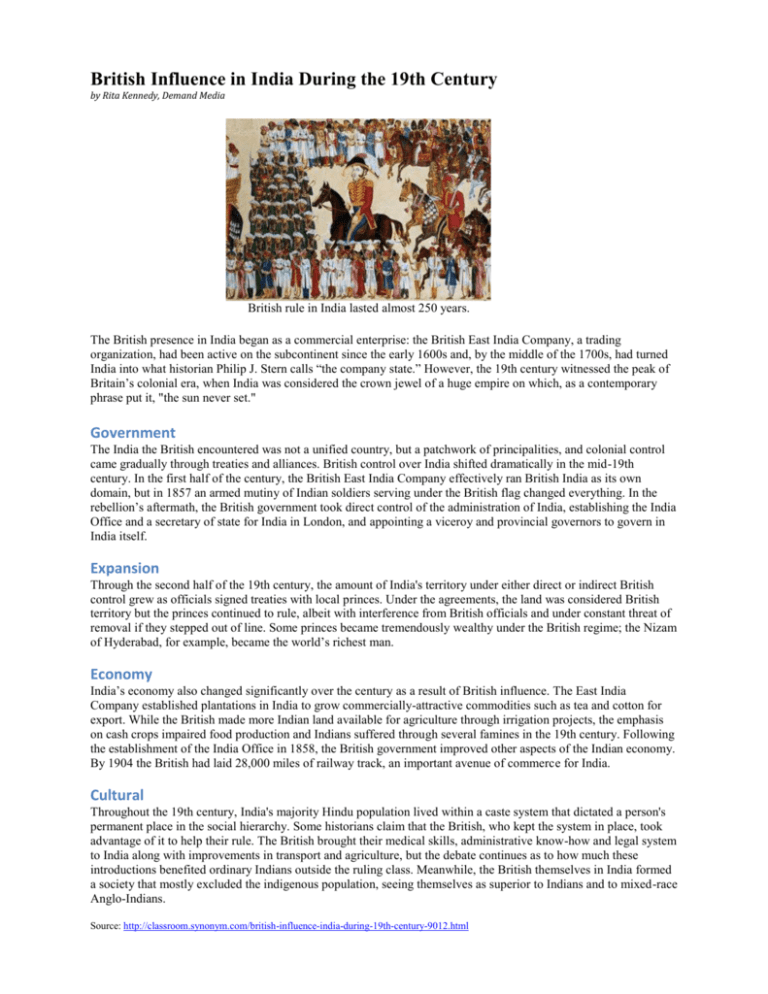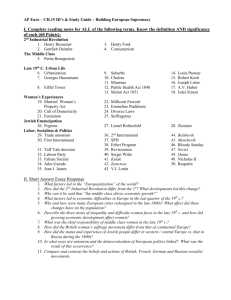British Influence in India During the 19th Century
advertisement

British Influence in India During the 19th Century by Rita Kennedy, Demand Media British rule in India lasted almost 250 years. The British presence in India began as a commercial enterprise: the British East India Company, a trading organization, had been active on the subcontinent since the early 1600s and, by the middle of the 1700s, had turned India into what historian Philip J. Stern calls “the company state.” However, the 19th century witnessed the peak of Britain’s colonial era, when India was considered the crown jewel of a huge empire on which, as a contemporary phrase put it, "the sun never set." Government The India the British encountered was not a unified country, but a patchwork of principalities, and colonial control came gradually through treaties and alliances. British control over India shifted dramatically in the mid-19th century. In the first half of the century, the British East India Company effectively ran British India as its own domain, but in 1857 an armed mutiny of Indian soldiers serving under the British flag changed everything. In the rebellion’s aftermath, the British government took direct control of the administration of India, establishing the India Office and a secretary of state for India in London, and appointing a viceroy and provincial governors to govern in India itself. Expansion Through the second half of the 19th century, the amount of India's territory under either direct or indirect British control grew as officials signed treaties with local princes. Under the agreements, the land was considered British territory but the princes continued to rule, albeit with interference from British officials and under constant threat of removal if they stepped out of line. Some princes became tremendously wealthy under the British regime; the Nizam of Hyderabad, for example, became the world’s richest man. Economy India’s economy also changed significantly over the century as a result of British influence. The East India Company established plantations in India to grow commercially-attractive commodities such as tea and cotton for export. While the British made more Indian land available for agriculture through irrigation projects, the emphasis on cash crops impaired food production and Indians suffered through several famines in the 19th century. Following the establishment of the India Office in 1858, the British government improved other aspects of the Indian economy. By 1904 the British had laid 28,000 miles of railway track, an important avenue of commerce for India. Cultural Throughout the 19th century, India's majority Hindu population lived within a caste system that dictated a person's permanent place in the social hierarchy. Some historians claim that the British, who kept the system in place, took advantage of it to help their rule. The British brought their medical skills, administrative know-how and legal system to India along with improvements in transport and agriculture, but the debate continues as to how much these introductions benefited ordinary Indians outside the ruling class. Meanwhile, the British themselves in India formed a society that mostly excluded the indigenous population, seeing themselves as superior to Indians and to mixed-race Anglo-Indians. Source: http://classroom.synonym.com/british-influence-india-during-19th-century-9012.html











